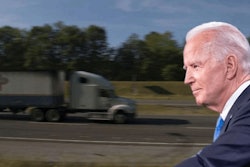 .
.California took another leap toward a zero-emission future when it announced in June every new medium- and heavy-duty truck sold in the state will be required to be zero-emission by 2045.
Three weeks later it was joined by 15 other states and the District of Columbia on a Memorandum of Understanding (MOU) to collaboratively work together to achieve 100 percent zero-emission vehicle (ZEV) sales on trucks by 2050, with an intermediate target of 30 percent ZEV sales by 2030.
Known internationally as a leader in air and emission regulations, the news California was taking more action to support zero-emission technology wasn’t a surprise to anyone in the new truck business. But the state’s aggressive timeline set targets that hadn’t previously existed on the industry’s horizon, while its swift backing from 30 percent of the republic showed California’s Air Resources Board (CARB) isn’t a solo instigator against trucking’s status quo anymore.
When it comes to air quality and emission regulations, where California leads, America often follows.
CARB was established in 1967 under then-Gov. Ronald Reagan as the state’s “clean air agency.” Situated within the state’s Environmental Protection Agency (EPA), CARB is the only state agency with federal EPA clearance to set its own emission standards — a power CARB has used to curtail air pollution in its state and push progressive air quality policy across the country.
In 2007, California was the first state to restrict idle times for heavy trucks; in 2009, it was given authority by the EPA to develop its own limits on greenhouse gas emissions after an initial 2008 denial. The state also factored heavily in the development of the EPA Phase I and Phase II emission and fuel economy standards that have defined trucking over the last two decades.
“CARB carries weight in federal policymaking simply because of the vast size of California’s economy and transport sector,” says Robert Bryce, a Texas-based author and journalist who has covered the energy sector for three decades. “That influence will be around for a long time.”
One place where that influence is visible is July’s MOU. Because of its unique position as the only state capable of directly superseding EPA regulations, California regularly enacts air quality standards that exceed EPA regulations or proposed regulations.
In some cases these standards are met with national skepticism, in other cases they are supported by a coalition of states, such as what occurred with July’s announcement. These events are challenging for federal regulators and industry, as they are suddenly thrust into a position of considering California’s regulations or accepting a reality in which every state can pick and choose the California and/or federal regulations they see it.
“We recognize the unique air quality issues California faces and CARB’s commitment to addressing those challenges,” says Katie Zarich, manager, external communications, Cummins. “Investing in developing technologies to meet standards specific to California is a challenge for the industry.”
Cummins isn’t alone on that. Many other members within the Heavy Duty Manufacturers Association (HDMA) also find California’s isolated decision-making cumbersome, says Tim Kraus, HDMA president and COO.
Kraus says many of HDMA’s members came to support EPA Phase I and II emission and fuel economy standards because of the collaborative nature in which they were composed. He says EPA regulators received input from manufacturers, motor carriers, industry groups, private organizations and the general public while developing the standards, and eventually settled on a pathway to implementation that was reasonable and measured while still being environmentally progressive.
Yet when California works in isolation, manufacturers, industry and citizens have less say, which means when other states throw their support behind a new California proposal, manufacturers are suddenly forced to evaluate which proposed guidelines (federal or California-generated) they should adhere to in their research and development.
Kraus says most choose to focus their attention on California’s proposals because it is easier to scale back on development if the state changes its timeline or abandons its proposals than suddenly ramp up R&D if a California idea is accepted nationwide.
“Our members work on the assumption that the most progressive scenario is the likely scenario,” he says.
 California’s Air Resources Board (CARB) is the only state entity in the U.S. that has the authority to develop its own emission standards.
California’s Air Resources Board (CARB) is the only state entity in the U.S. that has the authority to develop its own emission standards.But just because OEMs and suppliers have learned to adapt to CARB doesn’t mean they support the state’s oversized influence on national regulations. What CARB believes is necessary to reduce air pollution in Los Angeles or San Francisco might not be necessary in other areas, and oftentimes CARB’s emission regulations are far more advanced than what the American free market desires.
One such example is playing out in the state today. California last week voted unanimously to adopt the Heavy-Duty Low NOx Omnibus Rule, which would set strict emissions criteria for all engines sold in the state by 2024 and override the NOx regulations defined by EPA’s Phase II regulations.
The newly founded Truck Dealers Alliance of California (TDAC) urged California Gov. Gavin Newsom to direct CARB to instead align with the EPA standards for low-NOx truck engine standards for 2027.
In addressing the then-proposed rule and founding of TDAC last month, the American Truck Dealers (ATD) stated, “For California-based fleets, a California-only engine standard will result in higher equipment costs, which will place those fleets and their dealer partners at a competitive disadvantage when contending with fleets and dealerships based out of state. A single, national engine standard across the U.S. is the only way to ensure a consistent and level playing field for all equipment operators and vendors in California.”
CARB has admitted to TDAC that passing the Omnibus rule will increase service needs on California-based equipment, says TDAC Interim Director Matt Schrap.
“We would likely see increased service work because customers would be holding onto equipment longer,” he says. “That defeats the purpose of what they’re trying to accomplish here and doesn’t do anything to lend business certainty to dealerships in California who are again caught in the middle of whether or not the ARB is actually going to be able to do this legally, and at the same time it sends a message that there really is very little business consideration for companies operating in California when it comes to the latest suite of regulatory issues that are heading at us.”
Kraus mentions California’s push for 50-mile per gallon automobiles as another example of the agency’s overreach. CARB voted to require automakers to average greater than 54 miles per gallon for their new model year cars by 2025. But the most popular light-duty vehicles sold in the U.S. last year were the Ford F-Series, Dodge Ram and Chevrolet Silverado trucks, and by a large margin. Ford and Chevy trucks were in the top 10 in California in 2018 as well.
“[California is] pushing to reach 70 miles per gallon but American taxpayers are still buying vehicles that reach 22 miles per gallon,” Kraus says.
That disconnect between state regulators and the American vehicle-buying public seems unlikely to recede on its own. Which begs the question, how much larger could California’s influence on national emission regulations become?
Bryce pegs the upcoming election as “the most consequential election in modern American history” regarding energy issues. He says former Vice President Joe Biden has pledged to “electrify transportation and make the U.S. ‘net zero’ on greenhouse gas emissions by 2050” — a move that, if acted upon, would unquestionably be supported by CARB.
But the re-election of President Donald Trump wouldn’t eliminate CARB’s national influence, either. California’s summer announcements indicate the state is comfortable forging its own emission path regardless of federal support and likely would continue to do so if Trump stays in office. Additionally, despite high sales volumes for light-duty trucks, Pew Research indicates 71 percent of Americans support plans to reduce vehicle emissions.
Manufacturers are aware of the latter and have been diversifying their product lines accordingly.
Zarich says at Cummins it is the company’s mission “to power a more prosperous world. We do this by helping customers succeed through innovative and dependable products that are good for the customer and the environment. Cummins is a global technology with a broad portfolio of power solutions, and we’re committed to delivering the technologies our customers need,” she says.
Which brings the conversation back to medium- and heavy-duty ZEV.
Laurie Holmes, senior director, environmental policy, Motor and Equipment Manufacturers Association (MEMA), says the U.S. EPA is yet to suggest any national mandates for ZEV, but California’s recent announcement and coalition support suggest such a conversation could occur in the future.
Holmes adds a few MEMA members valued the boldness of CARB’s plan — “There are suppliers out there who felt there does need to be a jump start toward ZEV mandates,” she says — though most believe the recent strides taken toward lower emission vehicles has created a healthy distribution of those powertrains and a logical path toward improving them over a more gradual period than proposed by CARB.
She says MEMA communicated those sentiments to CARB and expressed interest in participating in the state’s deliberations to finalize its ZEV regulations.
If CARB’s authority in developing emission regulations is unlikely to diminish, Holmes says manufacturers and industry would be best served to work with the state’s regulators as it does with the U.S. EPA. “Our main message to CARB has been ‘Let’s make sure those targets are realistic,’” she says.











